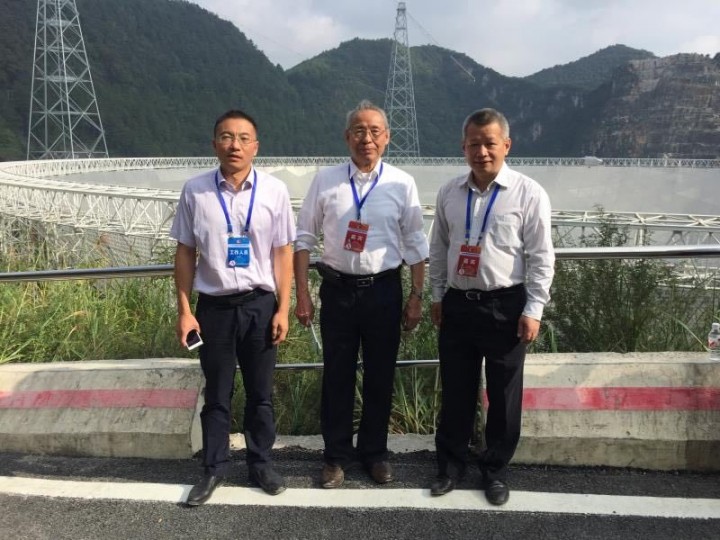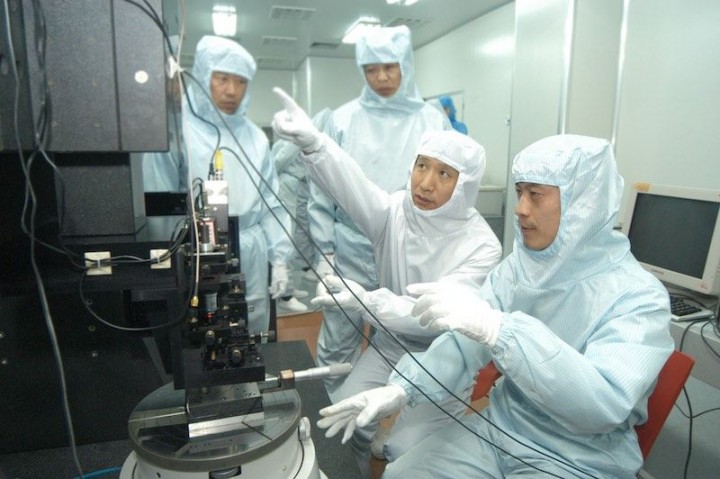With the founding of the People’s Republic of China, over 800 young academics, at an average age of 27.5, assembled in the northeast corner of the nation from all over the country. They were to undertake the task of teaching and research at the Harbin Institute of Technology (HIT) in Harbin.
In about a decade, HIT established 24 majors and nurtured a number of talented students who later contributed their solid theoretical foundation and strong engineering competence for significant national projects. As HIT met the “urgent need” for the initial process of industrialization in the country, HIT was thus reputed as “the New China’s Cradle of Engineers”.
For over half a century, generations of HITers have been striving to meet the needs of the nation, taking initiative to undertake cutting-edge projects and to enhance national capacity.
“Master + Team” mode to have young scholars standing in the C position
A cable net made of 6670 steel cables, hung on a ring beam with a diameter of 500 meters supported by 50 huge steel columns; the cable net is covered with 4450 pieces; under the cable net are 2225 pull-down cables, each of which is fixed to an actuator on the ground, and the shape of the cable net is changed by manipulating the actuator and pulling the pull-down cable so as to collect and observe astronomical signals.
The above describes the 500-meter aperture spherical radio telescope (FAST), also known as China’s Tianyan, or “Sky Eye”, a national major scientific and technological infrastructure. A team in the Space Structures Research Center of HIT (SSRC-HIT) was the one to undertake the design of the active reflector support structure for FAST.
It was a tough task. However, Shen Shizhao, Fellow of Chinese Academy of Engineering (CAE) and founder of the SSRC-HIT, immediately set out with his research team to make a general proposal for the telescope’s reflecting surface structure. They conducted research on key structural technologies and did the preliminary design on the reflecting surface structure system.
It was a project that lasted over a decade.
Scientific research needs multilateral collaboration and collective innovation. At HIT, this is known as the “Master + Team” mode.
Among the team members, Prof. Fan Feng, currently assistant to the president of HIT and an academic in the School of Civil Engineering, was at 32 when he became the chief engineer of the structural system in the FAST project. Prof. Qian Hongliang, Dean of the School of Marine Engineering at HIT’s Weihai campus, was only at 24, doing his master’s degree back then. The team also comprised some other younger students doing their postgraduate and doctoral degrees.

The picture shows Shen Shizhao, Fan Feng, and Qian Hongliang attending the completion ceremony of the FAST project
Fan Feng remembers that the first four years was spent on the program design and feasibility studies. For solving key technical problems, Shen Shizhao proposed general research lines of thought, which was to, first, exclude non-controlling factors through systematic assessment. Then they would conduct extensive and comprehensive analyses on the remaining variables. That was to ensure the reliability of the results. Following this line, Fan Feng, Qian Hongliang and other team members conducted a wide scope of statistical analyses, simulation, and experimentation.
In March 2006, with the support of Shen Shizhao, Fan Feng went to Beijing to join a final international review meeting for the start of the national project FAST. Fan reported the proposal on the flexible cable network of the active reflective surface. The proposal finally reached unanimous approval from the participating experts. As a young researcher, he gained rich experience through reporting this proposal.
In accompany with the process of the construction of FAST, Fan Feng has transformed from a novice researcher to a chief scientist for national key science & technology projects and a leading academic. He recounted, “Personally speaking, it was an opportunity and also a challenge for me to join and conduct research work for national major projects at a young age. Prof. Shen’s trust and supervision were invaluable to my growth.”
“Differentiated cultivation” to develop top level R&D innovation capacity
For decades, the scientific research mode of “Master + Team” that features “one goose leads the way and the flock fly together” has long become a tradition at HIT.
In the field of high-end instrumentation research, there is a dynamic young team, named the Ultra Precision Instrument Technology Innovation Team, with the majority of team members as academics in their 20-40s and postgraduates and doctoral students.
For over three decades, under the leadership of Tan Jiubin, Director of the Institute of Precision Instrument Engineering and Fellow of CAE, the team has developed about 30 types of measuring devices at the national standard and large-scale ultra-precision instruments and equipment. They established an ultra-precision measuring system for our national precision measuring and equipment manufacturing field. The precision level has reached international forefront standard. They solved key problems in ultra-precision measurement in R&D and manufacturing of some 30 kinds of high-end equipment, including national defense facilities, aeroengines, and satellite cameras.

The picture shows Tan Jiubin leading his team in R&D for high-end instruments and equipment
“The achievement that HIT got today derives from the Party Central Committee’s affectionate care and high attention, from the needs of the Party and the Country, and from the advanced layout and successive endeavor of generations of HITers.” Xiong Sihao, Secretary of the Party Committee of HIT, said that HIT should consistently aim for the mission of self-reliance and self-improvement in high-level scientific and technological innovation, align our work with national strategic goals and strategic tasks, solidify the exploration in the frontiers of foundational research and key technological breakthroughs. We need to further combine the development of science and technology as the first productivity, the cultivation of talents as the first resource, and the innovation as the first driving force. We will comprehensively promote reform in four key areas, namely personnel training, team building, scientific research and internal governance. We will continue to work on national priorities, nurture outstanding talents, and make novel and greater contributions to building a strong scientific and technological power and realizing the great rejuvenation of the Chinese nation.
News from China Youth Daily: https://s.cyol.com/articles/2021-06/25/content_rb7wvotv.html?gid=z1RJLO1q


